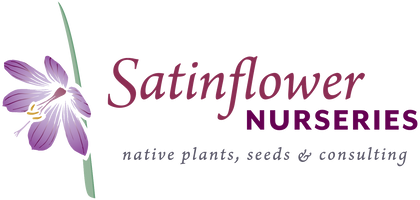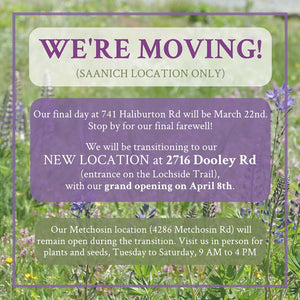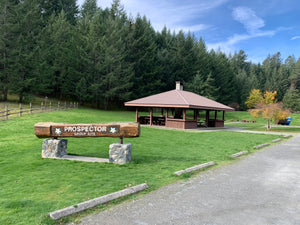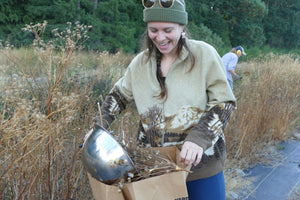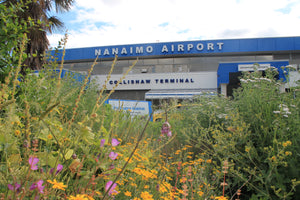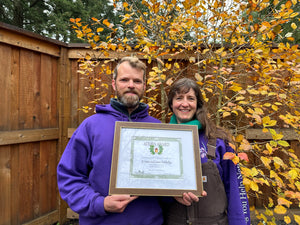The Nature of Blenkinsop Valley

By: Abigail Hyde
Throughout the Native Seed & Growing Project, seven field trips have highlighted the importance, ecology, uses, and histories of native trees and shrubs of Southern Vancouver Island. The project ran from February 1st to March 31st in partnership with Satinflower Nurseries and the Gulf Islands National Park Reserve. On March 25th, we had our final field trip; a walk through the Blenkinsop Valley with biologist and botanist James Miskelly.
The walk began as a reflection of the historical vegetation of the Blenkinsop Valley. James explained that the natural flora of the Blenkinsop Valley was extraordinarily diverse in the past. The natural flora of the Blenkinsop Valley was extraordinarily diverse and unique because there was no natural outflow from Blenkinsop Lake. The cold air and water trap created perfect conditions for a sphagnum bog which hosted many species of plants. The naturalist George Hardy recorded an extensive list of the species present in the bog prior to agriculturalization and drainage of the valley. Today little trace of those communities remains, but some of the trees and shrubs associated with the original habitats can still be found along the Lochside Regional Trail.
Points of discussion started with our earliest bloomer, Oemleria cerasiformis, June Plum/Osoberry. June Plum is a deciduous shrub with pendulous clusters of white flowers in very early spring to support early-flying insects like mason bees and flies. This species is dioecious, meaning there is a male and female plant, one with pistils (female) and one with stamens (male). We observed both the female and male plants - shown below. The male has larger flower clusters and the female has smaller flowers and leaves out earlier.

Figure 1. Oemleria cerasiformis, June Plum/Osoberry. The left image is the female plant, and the right is the male plant.

Figure 2. James in front of the Oemleria cerasiformis, June Plum/Osoberry.

Figure 3. Lonicera involucrata, Black Twinberry is a look-alike of June Plum in the early spring. You can differentiate the species because Black Twinberry has opposite buds, unlike June Plum, which has alternating buds.
The next species we observed was Crataegus douglasii, Black Hawthorn. Black Hawthorn is native, unlike Crataegus monogyna, English Hawthorn, the invasive species on the Island. However, both species are present along the Lochside Trail.
Black Hawthorn has apomictic seeds, which means that the seeds are clones of the parent plant. This characteristic is fascinating because seeds tend to imply sexual reproduction, but in this scenario, it is a form of asexual seed formation. Apomixis bypasses the need for male fertilization.

Figure 4. Crataegus douglasii, Black Hawthorn. The left image shows the black berries and the right shows its flowers.
There are two species of native Hathorn on the island: Crataegus douglasii and Crataegus gaylussacia. C. gayussacia has double the number of stamens (~10) as C. douglasii (~5). In the past, they were considered different varieties (C. gaylusaccia was C. douglasii var. suksdorfii), but each is now considered a species in its own right.

Figure 5. Crataegus gaylussacia. Photo courtesy of Wylie Thomas.

Figure 6. Crataegus monogyna, English Hawthorn. It has more deeply-lobed leaves and red berries. (www.nwcb.wa.gov/weeds/english-hawthorn).
Frangula purshiana ssp. purshiana, Cascara, is another beautiful small tree observed on the trail. Cascara has naked buds, which can be used as an ID tool - some say the buds look like hands in prayer. Typically, leaf and flower buds are covered by scales which help seal moisture and protect the buds from harsh elements. Only a few local species have naked buds. They are somehow able to survive the winter without the protection that the buds of other species enjoy.

Figure 7.The left image is Frangula purshiana ssp. purshiana, Cascara berries and the right image shows the naked bud. You can see the leaf buds on either side of the flower bud in the centre.
Another species we saw with naked buds is Cornus sericea ssp. sericea, Red-osier Dogwood. Red-osier Dogwood is a species that has dark red branches that stand out in the winter. They are prevalent in wet-moist sites in full sun to partial shade.

Figure 8. June Plum amongst a thick stand of Red-osier Dogwood.

Figure 8. Sambucus racemosa, Red Elderberry, budding out. You can see the bud scales clearly in this image. Red Elderberry is aslo adapted to wet/moist sites.
Larger tree species we observed were Betula papyrifera, Paper Birch, Populus trichocarpa, Black Cottonwood, and Populus tremuloides, Trembling Aspen. Paper Birch was very exciting to observe because Blenkinsop and Rithet's Bog are the only local places where natural stands exist. Both natural stands occur on soils derived from peat bogs. Paper Birch’s name comes from the thin white bark's tendency to peel from the trunk. Betula pendula, Weeping Birch, is more a commonly seen tree in boulevards and yards, but it is native to Europe and parts of Asia.

Figure 9. The group in front of a Paper Birch Tree.

Figure 10. Paper Birch Tree.
Trembling Aspen is prevalent all along Southern Vancouver Island, but is still a special species to behold because they grow in clonal patches. This means the young shoots are identical to the parent tree. Aspen groves can often be distinguished in the fall when the leaves change colour all at once. Trembling Aspen has a very broad range, but there is research that suggests that the aspen west of the cascades is genetically distinct and may one day have a name of its own.

Figure 11. Populus tremuloides, Trembling Aspen.
Thank you to everyone that took part in the project; we hope you enjoyed the experience and learned something new! We will be running the program again next year so stay tuned for the Native Seed & Growing Project 2024.
- Abigail Hyde
